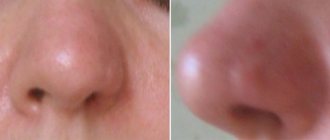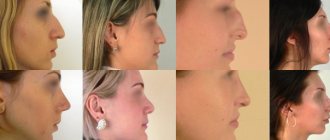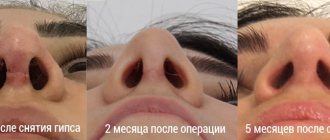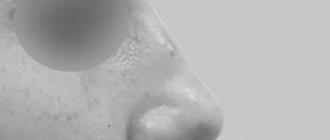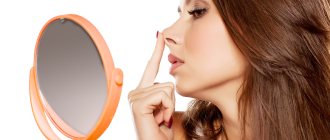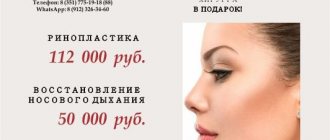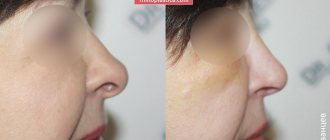- Department of Plastic Surgery
Department of Plastic Surgery » - Rhinoplasty
Being the central figure of the face, the nose plays a decisive role in the entire appearance of a person. Defects in appearance that cannot be hidden - a hump of the nose, its non-standard size or asymmetry - deprive the face of charm and expressiveness. But do not despair: modern safe methods of plastic surgery can easily and safely solve the problem. An elegant, perfectly proportional nose will become an irresistible “highlight” of your updated look.
What is rhinoplasty
Rhinoplasty is a plastic surgery that corrects aesthetic imperfections of the nose, as well as improving its functional parameters. The most common complaints about the shape and size of the external nose:
- presence of a hump;
- elongated or wide tip;
- dysplasia of the nasal pyramid;
- deviated septum, visible from the outside;
- retraction of the back and base of the nose.
External deformations are often accompanied by internal deviation of the bones, which interferes with normal nasal breathing. For each type of deviation from the norm, appropriate surgical correction methods are used. The innovative aesthetic surgery piezorhinoplasty has provided a qualitatively new approach to nasal surgery, providing an impeccable result with minimal invasiveness of the method.
Advantages of piezorhinoplasty at the RAMI clinic
The multidisciplinary clinic “RAMI” is one of the few in St. Petersburg that performs nose correction using the piezorhinoplasty method. This allows you to achieve significant advantages compared to classic nose surgery:
- Thanks to the highest precision of manipulations, fineness and precision of lines are achieved;
- the intervention takes place in a gentle manner - bone structures are exposed, and soft tissues, blood vessels and the mucous membrane that lies under the bone tissue remain undamaged;
- wounds, swelling, hematomas, hemorrhages under the skin are formed in much smaller quantities than with traditional rhinoplasty;
- the rehabilitation period is halved.
Doctor's opinion
The use of piezoultrasound waves has made it possible to abandon the classic surgical instruments for rhinoplasty - chisels and hammers - which many patients associate with uncontrolled osteotomy.
Focused ultrasound has a local effect, strictly within the problem area - thus, cutting the bone is replaced by delicate grinding. And we are no longer talking about standard plastic surgery, but about artistic rhinosculpture. Kardov Khazrit Muzarinovich, plastic surgeon, experienced specialist in piezorhinoplasty.
In what cases is rhinoplasty necessary?
Main indications for nasal surgery:
- congenital anatomical features - a wide or long bridge of the nose, the presence of a depression or hump, an uneven septum, irregular diameter of the nostrils, deformation of the tip, and so on;
- consequences of fractures and other injuries;
- unsatisfactory results after previous rhinoplasty operations.
Laser rhinoplasty
Innovative techniques used at the rhinoplasty center of Dr. Alexander Markushin make it possible to achieve optimal results with minimal tissue damage.
Laser rhinoplasty reduces postoperative rehabilitation time, opening up new prospects for aesthetic or medical corrections of the shape, size, and configuration of the nose. In addition, the very concept of a scalpel instills a feeling of anxiety in patients, making them afraid of going to a plastic surgeon. Laser technologies are much safer, practically painless, and do not leave visible marks.
How does laser rhinoplasty work?
The laser beam emerging from a specially designed knife allows the plastic surgeon to perform any manipulations as accurately as possible, minimally damaging the tissue adjacent to the surgical field. The experienced hands of a specialist quickly cut through the required area of tissue, gaining access to the desired location.
The consequences for the body of the person being operated on in this case are insignificant, and recovery and healing proceeds much faster.
In addition to tissue dissection, the equipment performs a wide range of operations.
- Seals vessels on the surgical field, minimizing blood loss.
- Disinfects tissue during dissection due to the action of a laser beam.
- Stimulates cell regeneration processes, reducing the time for the body to recover.
- Easily softens cartilage and bone tissue for working with the nasal skeleton.
With laser rhinoplasty, the penetration of pathogenic microorganisms into the wound is almost impossible, which improves the effectiveness of plastic surgery, reducing the chances of negative consequences. The time required for rhinoplasty is reduced significantly, and the rehabilitation process takes no more than a few months.
Important!!!
Laser rhinoplasty is ideal for complex operations when changing congenital injuries or injuries sustained during an accident or sports competition.
We weigh the pros and cons of laser nose correction
Most of the negative reviews are subjective, mainly the opinion of retrogrades who are disgusted by technological progress and everything connected with it. The emphasis in such reviews is on the high cost, the risk of equipment failure during surgery, and the inability to accurately control the operation of the laser knife. But, according to most patients, there are many more advantages.
Taking into account the problems and the cost of long-term rehabilitation, laser rhinoplasty is actually not that expensive. The risk of side effects is reduced to zero. It expands the range of possibilities for correcting any pathologies without repeat rhinoplasty.
What can laser nose correction easily deal with?
In terms of indications, laser rhinoplasty is not much different from any other rhinoplasty.
The main reasons are
- difficulty breathing, aesthetic defects that appeared at birth or acquired after injuries,
- wide, too upturned or hooked tip of the nose,
- large or too small nose size, spoiling the overall appearance,
- asymmetry of the nostrils or wings of the nose,
- a curved bridge of the nose, impeding the normal passage of air through the nasal passages,
- a hump or hole on the bridge of the nose, spoiling the appearance,
- any congenital or acquired aesthetic defects.
An experienced plastic surgeon, using the capabilities of innovative equipment, can easily cope with any problems.
On a note!!!
The main advantage of the modern method of nose correction is risk reduction and acceleration of the body’s recovery processes.
What are the contraindications for laser rhinoplasty?
A typical set of contraindications generally accepted for any operation.
- With exacerbation of chronic kidney or liver diseases.
- All types of heart disease and blood vessels that can disrupt the normal functioning of the body during surgery.
- Any type of diabetes.
- Tumors of any kind, regardless of their location in the patient’s body.
- Blood diseases affecting clotting.
- Inflammatory processes at the site of surgery of any origin.
- Acne, rash, boils on the nose and adjacent tissues.
- Presence of difficult to treat infectious diseases.
- Any period of pregnancy or lactation.
Before scheduling the operation, the patient must undergo a complete instrumental and laboratory examination. Only after receiving objective data about the condition of the body for a given period of time, the plastic surgeon sets the day for the operation. The patient should follow all the recommendations of the attending physician as closely as possible during the period of preparation and after the operation.
Existing risk of complications
Most patients who undergo laser rhinoplasty report some unpleasant symptoms immediately after surgery, which quickly disappear if the doctor's instructions are strictly followed.
Swelling, bruising, and pain are much less than with classical plastic surgery, but they still occur. When correcting a deviated septum or other complex operations, the nasal canals are necessarily tamponed, which does not allow breathing through the nose for several days.
In fact, rhinoplasty is the jewelry work of an experienced specialist, so special attention must be paid to the choice of clinic and surgeon. The patient must be confident in the high qualifications of the rhinoplasty doctor, since he will have to completely trust his professionalism.
At the same time, we should not forget about the patient’s responsibility, since proper preparation and strict adherence to the instructions of the attending physician helps to avoid most negative consequences and accelerates tissue recovery after surgery.
Among the most common negative consequences, several should be noted:
- negative aesthetic result of rhinoplasty if recommendations are not followed;
- the appearance of asymmetry of the nostrils;
- increased curvature of the back;
- a sharp deterioration in breathing due to narrowing of the nasal canals;
- presence of septal perforation;
- damage to the nasal valve.
A new operation always means additional financial costs. Repeated rhinoplasty is possible only after complete recovery, which takes up to one and a half years. All this time you will have to put up with existing defects, so special attention should be paid to choosing a doctor for rhinoplasty.
Laser rhinoplasty technique
Despite the considerable cost, the number of people wishing to use the innovative method of changing the contours of the nose is only increasing every year. This is due to high effectiveness, minimal negative consequences, and rapid postoperative recovery.
If after classical rhinoplasty you can see the final result only after a year, then with laser rhinoplasty the recovery time is reduced to several months.
What steps should a patient who wishes to undergo rhinoplasty take?
- The first step is consultation, computer modeling.
- Then the client signs an agreement with the clinic, which spells out the rights and obligations of the parties.
- Carrying out the necessary instrumental and laboratory studies with consultations of specialized specialists.
- Choosing the optimal rhinoplasty method, scheduling the day of surgery.
- Preparation for surgery according to the doctor’s recommendations.
- Laser nose correction.
- Rehabilitation taking into account the individual characteristics of the body and the complexity of the operation performed.
The price for laser rhinoplasty is calculated after determining the type of operation, the complexity of the upcoming manipulations, and the characteristics of the patient’s body.
The main advantages of laser rhinoplasty
After surgical correction of the nose with a laser, there are practically no bruises, swelling, or pain. Minor swelling disappears relatively quickly. The laser instantly disinfects the operated field, while simultaneously sealing damaged capillaries, so there is zero risk of infection or bruising. It is much easier for a specialist to perform the most complex manipulations with cartilage tissue, which increases efficiency.
Postoperative rehabilitation
Despite the fact that laser rhinoplasty is a high-tech method that seriously reduces the risk of injury, it is necessary to take compliance with the rules during recovery as seriously as possible. Follow the instructions of the attending physician exactly, carrying out all the necessary manipulations to disinfect the sutures. Take the necessary medications to speed up regeneration. The maximum recovery period after laser nose correction is 6 months.
Dr. Markushin's Rhinoplasty Center offers the optimal solution for quickly transforming an aesthetically attractive appearance or eliminating problems with nasal breathing. The price of services fully corresponds to the quality of service.
Progress of the operation
Depending on the objectives of the operation, open or closed access is used. A closed operation involves making an incision along the circumference of the nostrils, an open operation is supplemented by crossing the skin septum (columella) between the nostrils. Work with hard and soft tissues subject to correction is carried out using an expert piezoelectric apparatus for bone surgery. Automatic material for rhinosculpting is initially taken from the patient’s nasal septum, and in case of repeated surgery, from the costal cartilage. The operation is performed only under general anesthesia and lasts 3–4 hours.
Rhinoplasty technique:
As described above, there are many types of surgical interventions on the nose. The main ones are plastic surgery of the nasal septum (septoplasty), plastic surgery of the terminal part of the nose, plastic surgery of the dorsum of the nose, and glabellar plastic surgery .
The incision for rhinoplasty is made along the upper circumference of the nostrils. The nasal column (columella) may also be crossed. The mucous membrane is peeled off and manipulations are performed on the cartilage and bones of the nose. The wings of the nose can be resected, including both the cartilage and the skin and mucous parts. In some cases, percutaneous osteotomy of the nasal bones is performed.
Recovery period
The use of a piezotome provides significant advantages for effective rehabilitation:
- from the first days of the postoperative period there is practically no pain;
- on the 10th day, all bruises and swelling usually disappear;
- 10–14 days after the operation, you will have to constantly wear a plaster or polymer splint, which slightly complicates nasal breathing;
- Within 2 weeks after removing the cast, the external nose is taped to reduce the degree of swelling. An inconspicuous flesh-colored tape looks neat on the nose;
- The patient continues taping manually for up to 3 months
The main rehabilitation period lasts 12–14 days, but the nose undergoes minor changes throughout the year - most often, unnoticed by others.
After rhinoplasty:
At the end of the operation, a fixing bandage is applied to the nose, which is worn for 5-7 days. Turundas with ointments are inserted into the nasal passages for 1-3 days. These manipulations help keep the nose in a new position.
The patient is discharged from the clinic the next day after rhinoplasty. After the operation, swelling and intradermal hemorrhages may be observed, which, gradually decreasing, finally disappear after 1-2 weeks.
After surgery, 3-5 dressing changes should be planned. The stitches are removed after a week. You must refrain from wearing glasses for a month. The total recovery time is 1-1.5 months. After this, you can already assume the final result. However, it is best to evaluate the result of nose surgery after a year.
Rehabilitation with a cosmetologist
Cosmetologists at the RAMI clinic are involved in rehabilitation treatment after rhinoplasty, starting 5–6 days after surgery. This helps to quickly get rid of post-operative marks and alleviate the patient’s general condition. The program includes:
- microcurrent lymphatic drainage – to strengthen the skin and tighten the oval of the face;
- PRP plasma therapy – for the purpose of powerful stimulation of cell regeneration;
- phototherapy of hematomas using the M22 multi-module system – for skin rejuvenation and coagulation of small vessels.
For detailed information about piezorhinoplasty and to make an appointment with a plastic surgeon, please call the clinic: +7.
